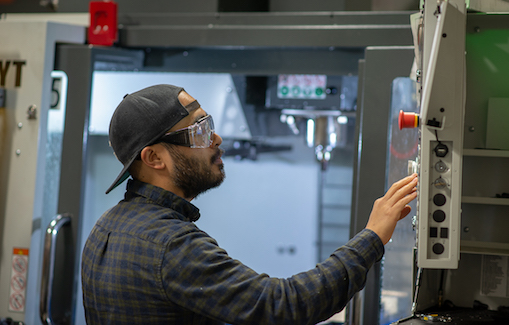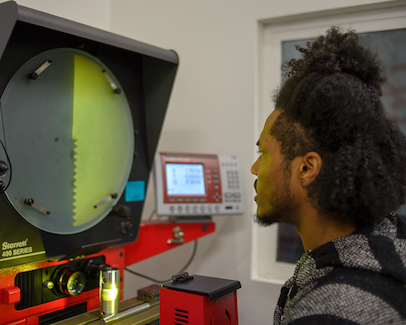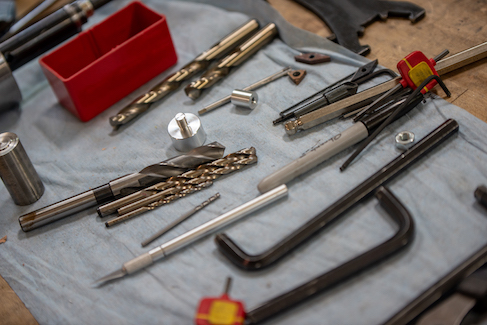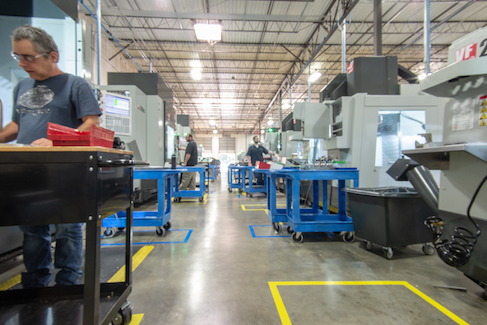Manufacturing is the Secondary Operation for This CNC Machining Shop
San Francisco-based Plethora Corp. shaves as much time as possible from the iterative design process. After developing software that enables customers to design for the shop’s capabilities in real time, this 2017 start-up delivers prototypes and production runs within three days.
Posted: June 1, 2020
BY STEPHANIE JOHNSTON
In late April, as many fabricators and machinists struggled to maintain production with fewer employees, Plethora Corp. was advertising for three positions: 2rd Shift, Toolroom Tech; 2nd Shift, Senior Machinist Lead; and Technical Enterprise Account Executive.
It’s not that the San Francisco-based CNC machining company wasn’t affected by the coronavirus pandemic. Few parts in personal protective equipment (PPE) parts are machined, so the company wasn’t pivoting to make parts for things like hospital cots and face shields. Instead, some customers pulled back on new product development but reordered more existing parts. Others used the downtime to make internal improvements before reopening, sending Plethora a fair amount of work related to hardware upgrades.
“We’re working more closely with procurement and sourcing, less so with product engineers and designers,” Marketing Director Matt Lukens said in mid-April. “We’re seeing coordination issues with customers who aren’t sure where to have us ship their orders. So we’re experiencing an increase in just-in-time deliveries, and are warehousing some parts for customers.”
In many ways, this is the type of pivot-on-a-dime scenario cofounders Jeremy Herrman and Nick Pinkston launched their software-driven metalworking company for.
More Than Manufacturing as a Service (MaaS)
Take a 2007 University of Pittsburgh computer engineering graduate (Herrman) and a 2008 University of Pittsburgh business marketing graduate (Pinkston).
Like many technology entrepreneurs attracted to manufacturing, they identified a supply chain weakness they felt qualified to fill: the gap between a designer’s vision for how a part fits into an assembly or product and the manufacturing engineer’s practical, hands-on know-how. In 2013, after three years of development, they began taking orders from customers via their proprietary manufacturability-analysis software and online tool with a CAD add-in that minimizes iterative back-and-forth’ing between the two parties.
Finishes, for example, show the value a manufacturing engineer can add. A design engineer or product designer probably wants the best-looking part, but a manufacturing engineer can point out where a chamfer would add cycle time; where a narrow, flat-bottomed hole would introduce the risk of a broken tool; or where a glass-smooth finish isn’t necessary for a part that won’t be visible in the final, assembled product.
Then add a former sheet metal and machine shop manager who’s managed contracts for companies like Apple (President and CEO Jim Quinn) and throw in roughly $24 million in venture capital. The result: a metalworking manufacturer that relies as much (if not more) on software as machines.
After uploading a 3-D part file, customers immediately receive manufacturability feedback, solutions to design issues, committed pricing, and turnaround times – not a traditional quote. The tool handles concurrent uploads, so customers can order multiple parts.
The platform supports Autodesk’s Inventor; Spatial Corp.’s ACIS; Dassault Systems’ CATIA V5 and SolidWorks; PTC’s Creo Parametric and Pro/ENGINEER (Creo Elements); Siemens’ NX, Parasolid, and Solid Edge; and international graphics exchange specification (IGES) and standard for the exchange of product data (STEP) file formats.
Plethora uses Autodesk Inventor to examine the 3-D part model and Autodesk HSMWorks to automatically program machines, including toolpath and workholding. The entire production process is validated via simulation before the machine’s operator starts the program and walks away.
“Every step of the manufacturing process – every cutting tool, machine parameter and material – is defined in our software, and our factory is connected to the online tool,” Pinkston said in 2017. “Our users can design for the factory’s capabilities while they are designing.”
Programming and Configuring for On-Demand Machining
All that saves tons of time, of course, and is why the company can deliver parts within three days. However, developing and refining software that analyzes capability and capacity in real time via machine learning is also time-consuming and labor-intensive.
“What sets us apart is the core algorithm that we use,” Quinn told Company Week. “We have PhDs in mathematics and materials sciences working directly with machinists to develop this software.”
Every machine and process is encoded. Plethora rigorously maintains and links the 3-D geometry of every tool, machine, and model. Every machine is equipped with an iPad that records any errors, and that information goes back to Plethora’s tech team – industrial engineers and software engineers – to analyze the issue and program any necessary tweaks.
“We know how the controllers work – everything,” Pinkston told Autodesk. “We’re probably the most characterized shop in existence, so we know very well what we can do. We have to be able to break the machine down and retool it very quickly. We have a very modular thing where all the machines are clones. A 3-axis milling machine is the same one everywhere, and the tooling is the same.”
To facilitate this interoperability, Plethora owns only Haas machines in various sizes: three lathes with live tooling and 22 mills in a mix of 3-, 3+2-, and 5-axis.
In addition, programs are designed to do the thinking for an operator, a process the company calls “strategy generation.” For example, each workstation is programmed to devise a progression, such as: ‘First I have to select this block of metal. Then I have to cut it to the approximate size. Then I have to load this thing and load it exactly this way.’
Automating operations with custom software enabled to understand the factory’s capacity and capabilities ensures customers receive realistic and solid turnaround times that aren’t subject to don’t change because of shifting internal priorities or crises. s with ever-changing priorities.
“There are a lot of in-process checks to confirm these things happened so we don’t make any mistakes,” Pinkston told Autodesk. “Because it’s easy to make mistakes when you’re going fast. And reconfigurability has a very high risk of crashing.”
4,000% Growth in Six Years
“We use the human-computer approach like a hybrid,” Pinkston told Autodesk. “Automation is great, but it’s brittle. Sometimes, it’ll do 99% of the job, but that last 1% requires a human. You have to make the manual workflow better in addition to doing this very fancy automation stuff. We’ve had to cross all those bridges. You can’t just fly over them.”
Clients have asked Plethora to manage production through other vendors. “It makes sense for us because it helps our manufacturing engineers gain a deeper understanding of our clients’ overall needs,” says Quinn. “In turn, we’re able to offer suggestions and feedback that save clients time and money.”
In 2019, Plethora opened a 57,000-square-foot factory in Marietta, Ga., and has 65 employees working three shifts five days a week. Orders range from thousands of units for a consumer product goods company to ten units for, say, robotics and medical technology companies. The rest of the company’s 88 employees are in the San Francisco home office handling mostly administration, sales, and technology.
It’s hard to say what this year holds for any company in any industry, but Plethora grew 4,000% from 2016 to 2019.
The company’s long-term strategy is to apply the same manufacturability and automation principles to finishing and secondary operations that customers often require to provide a true one-stop shop. First, the company’s software developers are working on attaining International Traffic in Arms Regulations (ITAR) certification for its digital tools.















